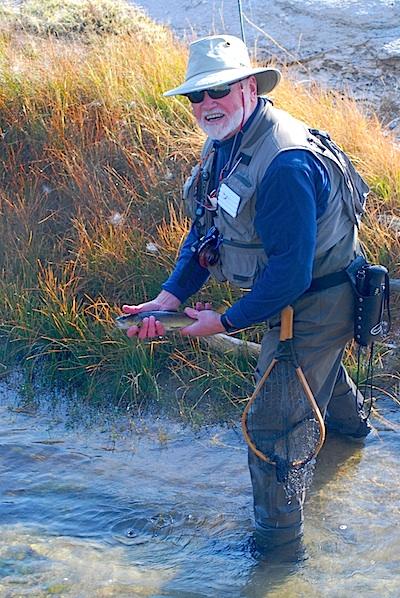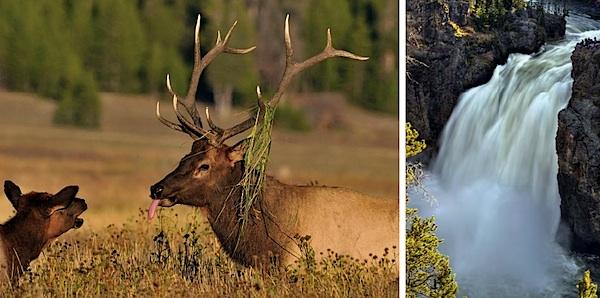
The Firehole River in Yellowstone is a bountiful trout fishery / Kurt Repanshek
Editor's note: This is a special advertiser-supported article from the Essential Park Guide, Fall 2014.
Finding yourself in West Yellowstone, Montana, this fall is the easy part. Deciding what to do, well, that could take some time.
Do you pedal to the south side of town and enter the rolling Rendezvous Trail System in the Targhee National Forest on your mountain bike, head into Yellowstone National Park to savor the photographic bounty of wildlife on the move or for a hike through the golden autumn, or wet a fly in some of the West's best blue-ribbon trout streams? Too little time, too many choices.
After you've chosen your base camp from West Yellowstone's wide range of lodging options, from individual cabins to full-amenity hotels, head out into the season. The west entrance to Yellowstone is your entry to fall fly fishing. Autumn is a magical time in the high country: the mosquitoes have died down; the nights are cold and the days warm; the skies are clear and crystal blue; the waters are clear. The brown trout in the Madison River are about to start their spawning runs up river, and they're hungry, huge, aggressive, and have a date with destiny, and you.
Though the tourist crowds have thinned on the rivers around West Yellowstone, you won't be alone either; the other critters are busy trying to prepare for the first snows, and then the gentle lock-down of winter. Along the Madison and Gallatin rivers the elk are bugling, the swans are gliding, the coyotes are leaping, and the bears are generally doing whatever they want to do (but will mind their own business if you do - but carry your bear spray and keep it handy, just the same).
From mid-August through the end of October you can catch some of these legendary fish. Hatches of caddis mayflies, and stoneflies, swarms of grasshoppers and ants, and the errant mouse, will keep them hungry, as these fish burn extra energy during the spawn. Imitations of terrestrials (ants, grasshoppers, and mice) are definitely on the trout menu, and bring the big fish to the surface along the Yellowstone and Madison.
While fish average around 16 to 17 inches, a two-footer is considered a really good fish, and every so often someone catches one even bigger. It's the stuff of legends and bar stories.
Just a few miles from West Yellowstone, you can fish Hebgen Lake, not just the premier stillwater fishing lake in Montana, but world famous as a dry fly fishery. Hebgen offers up a calm placid surface, extensive weed-beds, and 'gulping' trout. Large rainbow and brown trout become greedy 'gulpers' when slurping copious amounts of mayflies off the lake's glassy surface. Head down the lake on a guided drift boat, bring your own or rent a boat, or just walk the banks. Just be ready for a fight.
Fishing within the park is magical. You'll be in one of the most famous fisheries in the world, surrounded by some of the most amazing scenery. In late fall, try your luck on the Firehole River, and tantalize the rainbows with dry flies and streamers as geysers sputter nearby while the steam swirls through the cold air. Or fish the Yankee Jim Canyon of the Yellowstone River. It's primeval and the solitude will surround you.
Hiking and photography are pretty legendary in Yellowstone in the fall, too. Start right from town on the Riverside Trail that leads from the eastern end of Madison Avenue into the park. Some mountain bikers and anglers might join you on this trail, which leads to the Madison River. Head out early to enjoy both the morning light glinting off the river and with hopes of seeing some moose or bison along the river or in the surrounding meadows.
Drive into the park and you can hike the trails in the Lower Geyser Basin within 30 minutes (barring any wildlife jams), or drive a bit longer to reach the hot, colorful, and turbulent Norris Geyser Basin. If the basin is willing, you just might see Steamboat Geyser erupt during your walk on the basin boardwalk.
For some, solitude goes with the fall foliage. Visit overlooked Monument Geyser Basin about five miles south of Norris, for example. This basin was once a major tourist stop. These days it qualifies for hidden, largely due to its small road sign, but also due to the mile-long, uphill hike needed to reach the basin. You'll likely smell the sulphurous steam before you actually see, or hear, the basin. Once out of the trees you'll not find erupting geysers or sparkling hot springs. Rather, the basin features a collection of fuming cones rising above a small, rolling saddle, clasped on a ridge high above Gibbon Meadows.
You also don't need an arduous hike to enjoy autumn. The season brings the park's wildlife into view, as elk and bison move to the river valleys. The 14-mile-drive from West Yellowstone to Madison Junction offers numerous parking spots so you can focus on the bison and elk, instead of the road. Plan a late afternoon visit and you might see and hear the bugling bull elk summoning their harems.
Don't forget to stop at the Visitor Center in West Yellowstone to grab a West of Yellowstone Park map with its road-trip suggestions. For example, head up U.S. 191 north of town. This route takes you in and out of Yellowstone and you'll have a good chance to spot bears and bald eagles. Plus you can always stop to fish the creeks coming out of the park, or at Hebgen Lake.
However you decide to pass your time, when your visit ends, you'll find that you've been hooked on this wonderful season.

Bulls and cows are more visible in the fall in Yellowstone, while the Upper Falls of the Yellowstone River is always on display / Mike Polkowske



Add comment